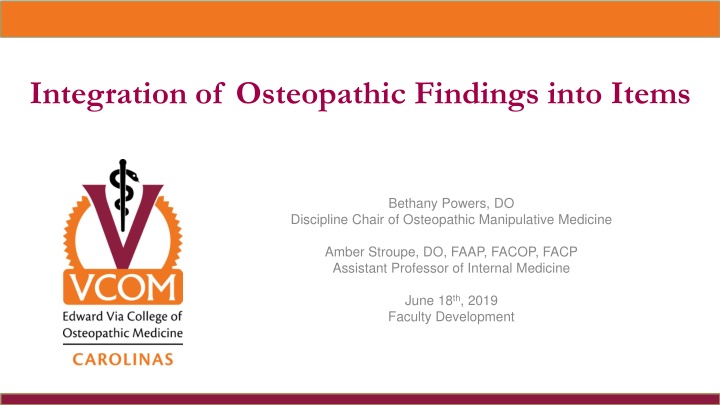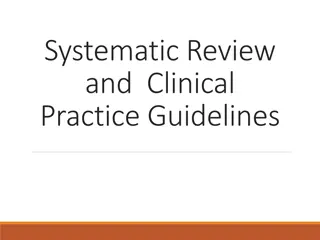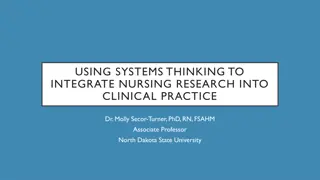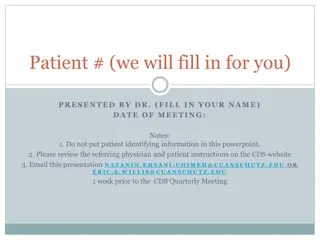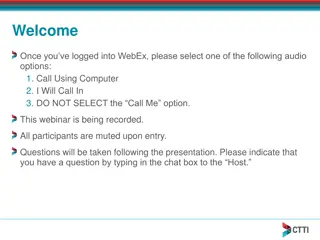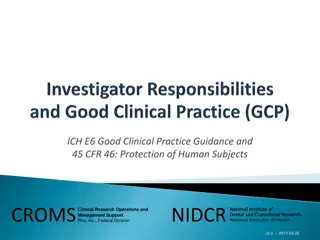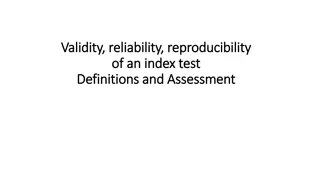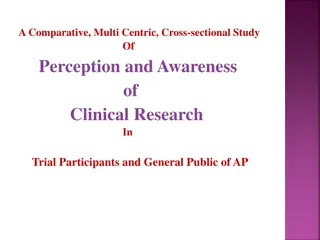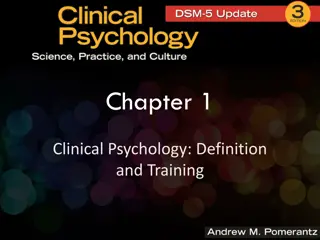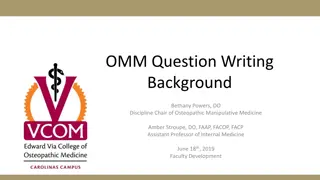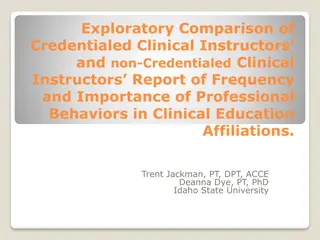Integrating Osteopathic Findings into Clinical Practice
This article discusses the incorporation of osteopathic findings into medical practice, focusing on recognizing components of the osteopathic structural examination, recent research studies, and how to integrate examination findings into item writing. Various case examples are provided to illustrate practical application in clinical scenarios. Facilitators include experts in Osteopathic Manipulative Medicine and Internal Medicine. The content aims to enhance understanding and utilization of osteopathic principles in patient care.
Download Presentation

Please find below an Image/Link to download the presentation.
The content on the website is provided AS IS for your information and personal use only. It may not be sold, licensed, or shared on other websites without obtaining consent from the author.If you encounter any issues during the download, it is possible that the publisher has removed the file from their server.
You are allowed to download the files provided on this website for personal or commercial use, subject to the condition that they are used lawfully. All files are the property of their respective owners.
The content on the website is provided AS IS for your information and personal use only. It may not be sold, licensed, or shared on other websites without obtaining consent from the author.
E N D
Presentation Transcript
Integration of Osteopathic Findings into Items Bethany Powers, DO Discipline Chair of Osteopathic Manipulative Medicine Amber Stroupe, DO, FAAP, FACOP, FACP Assistant Professor of Internal Medicine June 18th, 2019 Faculty Development
Objectives Recognize components of the osteopathic structural examination. Identify recent osteopathic research studies. Incorporate osteopathic examination findings into item writing.
Facilitators Rebecca Bowers, DO Lisa Carroll, MD Bethany Powers, DO Amber Stroupe, DO
Item Example #1 A 22-year-old male marathon runner presents to the office with complaint of right-sided rib pain when he runs long distances. Physical examination reveals normal heart and lung findings and an exhalation dysfunction at ribs 4-5 on the right. Which of the following muscles or muscle groups will be most useful in correcting this dysfunction utilizing a direct method? A. Anterior scalene B. Latissimus dorsi C. Pectoralis minor* D. Quadratus lumborum E. Serratus anterior Practice Exam COMLEX-USA Level 1
Item Example #2 A 1-day-old male is evaluated for failure to breast feed. Physical examination reveals poor coordination of lip and tongue motion, generalized hypotonia, bilateral condylar compression, a hand anomaly as shown in the exhibit, and marked inferior vertical strain. As this neonate grows, his facial anomalies will become more pronounced due to: A. Abnormal blood cell growth in the bone marrow B. Hypoplasia of the midline facial bones* C. Lack of cartilaginous growth plates D. Poor brain growth E. Premature closure of fontanelles Practice Exam COMLEX-USA Level 1
Item Example #3 A 55-year-old male presents to the emergency department with a 2-day history of severe epigastric pain and vomiting. Past medical history is negative for any similar episodes. He does not take any medications. He smokes cigarettes, has a 40 pack- year history, and consumes more than 8 cans of beer per day. Abdominal examination reveals epigastric tenderness. Laboratory studies reveal a serum amylase level of 467 U/L (reference range: 28-100 U/L) and a -glutamyltransferase level of 212 U/L (reference range: <55 U/L). Referred pain in this patient is transmitted to the spinal cord by which of the following nerves? A. B. C. D. E. F. Anterior rami of T1-T5 Anterior rami of T6-T10* Anterior rami of T11-T12 Posterior rami of T1-T5 Posterior rami of T6-T10 Posterior rami of T11-T12 Practice Exam COMLEX-USA Level 1
Item Example #4 A 22-year-old female is admitted to the hospital with a 2-day history of increased frequency of bowel movements with bloody stools and worsening abdominal cramping. She also complains of weakness. Past medical history reveals Crohn disease. Physical examination reveals: C2 flexed, rotated left, sidebent left T3 extended, rotated right, sidebent right Tenderness at the insertion of the left iliolumbar ligament Motion restriction at the left sacroiliac joint Fascial tension over the super mesenteric ganglion The somatic dysfunction at which site is most likely the result of increased sympathetic activity? A. B. C. D. E. C2 Iliolumbar ligament Sacroiliac joint Superior mesenteric ganglion* T3 Practice Exam COMLEX-USA Level 1
Item Example #5 A 25-year-old female presents to the office with a 3-day history of dysuria, urinary frequency, and foul-smelling urine. She denies fever, nausea, and vomiting. She has no prior history of similar symptoms. Vital signs reveal a temperature of 36.8 C (98.2 F), blood pressure 110/70 mmHg, heart rate 78/min, and respiratory rate 16/min. Physical examination reveals a soft abdomen with active bowel sounds and no indirect or rebound tenderness. She has mild to moderate tenderness over the bladder, the right pubic ramus, and the sacrotuberous ligament. There is restriction of sacral motion with sacral rocking. There is no pain with percussion over the costovertebral angles bilaterally. A urine dipstick is positive for leukocytes, hemolyzed blood, nitrites, and leukocyte esterase. A pregnancy test is negative. In addition to oral antibiotic therapy, the most appropriate next step is: A. B. C. D. E. Admission to the hospital for intravenous fluids CT scan of the abdomen and pelvis Osteopathic manipulative treatment* Referral to a urologist for cystoscopy Ultrasonography of the kidneys and ureters Practice Exam COMLEX-USA Level 2-CE
References COMLEX-USA Level 1 Practice Exam: https://nbomeapp.nbome.org/pls/apex_prod/f?p=301:5:1677089165 2683:::5:: COMLEX-USA Level 2-CE Practice Exam: https://nbomeapp.nbome.org/pls/apex_prod/f?p=301:5:4730369736 74:::5::
